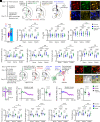Ameliorating parkinsonian motor dysfunction by targeting histamine receptors in entopeduncular nucleus-thalamus circuitry
- PMID: 37068253
- PMCID: PMC10151461
- DOI: 10.1073/pnas.2216247120
Ameliorating parkinsonian motor dysfunction by targeting histamine receptors in entopeduncular nucleus-thalamus circuitry
Abstract
In Parkinson's disease (PD), reduced dopamine levels in the basal ganglia have been associated with altered neuronal firing and motor dysfunction. It remains unclear whether the altered firing rate or pattern of basal ganglia neurons leads to parkinsonism-associated motor dysfunction. In the present study, we show that increased histaminergic innervation of the entopeduncular nucleus (EPN) in the mouse model of PD leads to activation of EPN parvalbumin (PV) neurons projecting to the thalamic motor nucleus via hyperpolarization-activated cyclic nucleotide-gated (HCN) channels coupled to postsynaptic H2R. Simultaneously, this effect is negatively regulated by presynaptic H3R activation in subthalamic nucleus (STN) glutamatergic neurons projecting to the EPN. Notably, the activation of both types of receptors ameliorates parkinsonism-associated motor dysfunction. Pharmacological activation of H2R or genetic upregulation of HCN2 in EPNPV neurons, which reduce neuronal burst firing, ameliorates parkinsonism-associated motor dysfunction independent of changes in the neuronal firing rate. In addition, optogenetic inhibition of EPNPV neurons and pharmacological activation or genetic upregulation of H3R in EPN-projecting STNGlu neurons ameliorate parkinsonism-associated motor dysfunction by reducing the firing rate rather than altering the firing pattern of EPNPV neurons. Thus, although a reduced firing rate and more regular firing pattern of EPNPV neurons correlate with amelioration in parkinsonism-associated motor dysfunction, the firing pattern appears to be more critical in this context. These results also confirm that targeting H2R and its downstream HCN2 channel in EPNPV neurons and H3R in EPN-projecting STNGlu neurons may represent potential therapeutic strategies for the clinical treatment of parkinsonism-associated motor dysfunction.
Keywords: H2R; H3R; Parkinson’s disease; entopeduncular nucleus; histamine.
Conflict of interest statement
The authors declare no competing interest.
Figures





References
-
- Aristieta A., Ruiz-Ortega J. A., Morera-Herreras T., Miguelez C., Ugedo L., Acute L-DOPA administration reverses changes in firing pattern and low frequency oscillatory activity in the entopeduncular nucleus from long term L-DOPA treated 6-OHDA-lesioned rats. Exp. Neurol. 322, 113036 (2019). - PubMed
Publication types
MeSH terms
Substances
LinkOut - more resources
Full Text Sources
Medical

